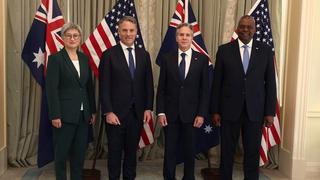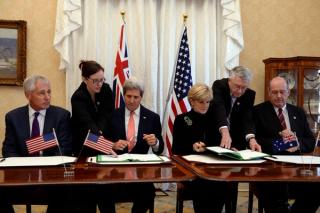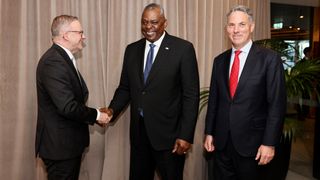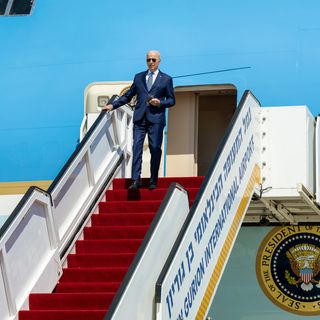On Saturday 29 July, Australian Defence Minister Richard Marles and Foreign Minister Penny Wong travelled to Brisbane to meet with their American counterparts, Secretary of Defense Lloyd Austin and Secretary of State Antony Blinken. The Australia-US Ministerial Consultations – commonly known as AUSMIN – are the most significant, regular forum to make progress on alliance issues, with a particular focus on the defence and foreign policy portfolios.
To complement the latest episode of the USSC Briefing Room podcast, The latest in Australia-US maritime security, what follows is an ‘outside the briefing room’ take on the topline developments from AUSMIN 2023. USSC Director of Research Jared Mondschein, sat down with three Centre experts Tom Corben, Alice Nason and Georgia Edmonstone, who gave their insights on the key highlights from this year’s meeting.
Read the Joint Statement on AUSMIN 2023 here.
Q. Alice, what is AUSMIN?
ALICE: AUSMIN is the premier bilateral diplomatic forum for the United States and Australia. The meetings are held regularly, and the key attendees are the Australian Foreign and Defence ministers and the US Defense Secretary and Secretary of State. This meeting is a chance to progress alliance cooperation across an array of critical issues. This year is important because it's the first year it's being held back in Australia after three years held in the United States. And this year it is synchronised with Talisman Sabre, which is the largest bilateral training exercise between our two countries.
Q. And can you tell me how long has it been going on?
ALICE: Since 1985, when the Kiwis left. It’s truly a long-standing initiative.

Q. Tom, could you talk about why it’s still ongoing? Is it actually significant or is it basically just an excuse for the diplomatic and defence chiefs to meet and have nice meals together?
TOM: I don't know if it's an excuse. I think those sorts of meetings are fairly important for making substantial progress on key bilateral initiatives. AUSMIN serves two main purposes, really. One is to flag new initiatives that are becoming part of the alliance agenda in the near future and to articulate the purpose behind those to some extent, as well as what that will actually look like in practice.
And in another sense, AUSMIN is about consolidating progress that has been made in the alliance since the last meeting or since previous initiatives were launched in different areas of the alliance, including defence cooperation, economic cooperation and now climate. So, the AUSMIN joint statement and the meetings themselves are really not only just about consolidating what's happening, but it's also about giving the general public and the broader international community, but particularly the Indo-Pacific, an idea about where the alliance is headed and the sorts of things it’s going to do.
Q. What are some of the greatest hits from AUSMIN in the past? What sort of bilateral accomplishments or achievements have there been?
TOM: AUSMIN is an opportunity for the United States and Australia to articulate their shared views on particular regional challenges. So, for instance, I think in the last five to seven years, you've seen a real hardening of consensus between the two countries on issues related to China's behaviour in Southeast Asia, but also its activities in Hong Kong, for example, or its coercive activities in the East and South China Seas. So, articulating those points of consensus is really important in the broader context of building out a collective united front against China's coercion in the region. And AUSMIN is a good forum to do that.
In terms of the actual practical things that have come out of AUSMIN, I'd say the Force Posture Initiatives which were announced in 2011, were probably one of the greatest hits, if you'd like to call it that. It’s essentially a combined US-Australia activity or set of activities based around particular military services using Australian facilities for exercises and operations. So far this has focused largely on enhanced Air Force cooperation. But you're starting to see, not just in this 2023 AUSMIN joint statement but the last couple of statements, an expanding focus on force posture initiatives as they relate to naval cooperation, but also to land cooperation. I think that was one of the quite notable outcomes from this AUSMIN statement.
Articulating those points of consensus is really important in the broader context of building out a collective united front against China's coercion in the region. And AUSMIN is a good forum to do that.
Q. From the economic security side, what were you looking for this AUSMIN to address?
GEORGIA: In some of the other recent multilateral forums that Australia and the United States have been part of, we've seen a lot of discussion on ‘supply chain diversification’. That's been a big buzzword, as has ‘increasing infrastructure investment’. The Pacific is a big area of importance there for Australia. So, it's not surprising to see some announcements around infrastructure investment and around the clean energy transition and supply chains.
We did get an announcement on further collaboration on infrastructure in the Pacific. The United States committed to the joint financing of infrastructure projects in the Pacific and new grant funding to build infrastructure. Australia has an existing infrastructure investment program in the Pacific – the Australian Infrastructure Financing Facility for the Pacific – and they've made a lot of investments in the Pacific region, in airports, ports, undersea cables and solar plants. Given the US increased focus on the Pacific, with the re-establishment of embassies in the region, it's good to see that the United States is also committed to putting its money where its mouth is and investing more in infrastructure in the region.
They also reaffirmed their commitment to the Blue Dot network, which is a forum to certify infrastructure projects to meet higher quality standards. That program was established between Australia, the United States and Japan to provide an alternative to Chinese infrastructure investments in the region by emphasising the quality of the infrastructure.
On the supply chains and clean energy front, there were no new announcements, but a lot of reaffirming of previous commitments. For example, they pointed to the Climate, Critical Minerals and Energy Transformation Compact. This is a framework that was announced earlier this year for the United States and Australia to coordinate policies and investment to support the expansion and diversification of clean energy and critical mineral supply chains, particularly through two-way investment in clean energy and critical minerals projects in each of the countries, and engagement with industries. But there weren't any new announcements aside from a commitment to implement and accelerate these existing agreements.
Q. So, it sounds like, from the economic security perspective, you saw a lot of reaffirmations in this?
GEORGIA: Yes, I counted 15 times that “reaffirmed” was mentioned in the communique, but there weren’t a lot of new announcements on economic issues.

Q. The announcements on defence capability and integration exceeded all expectations – more on that soon, but what about in terms of foreign policy and regional diplomacy?
ALICE: As usual, both countries reaffirmed their commitment to ASEAN centrality. But this statement carries a lot more weight from these two governments who have both made concerted diplomatic efforts in the region – for example, through the Biden administration's return of the United States to regional multilateral diplomacy and through Foreign Minister Wong's travel to all Southeast Asian countries, barring Myanmar, in her first year in office.
Other newly announced and reinvigorated areas of US-Australia cooperation leave room for regional partners to plug in. Our enhanced air cooperation, for example, is looking for other countries in the region to join to enhance regional maritime domain awareness. Otherwise, both Australia and the United States expressed a willingness to explore regional co-development and the co-production and sustainment of capability priorities. I think that this statement of intent heralds more promise for future larger trilateral and multilateral cooperation with regional partners. So, my expectations here were met, but I do think it's a ‘wait-and-see’ situation.
On climate, I'd echo Georgia that there was little new to announce. Everything that was mentioned lacked specificity beyond welcoming Australia's bid to host COP-31 and strengthen regional cooperation broadly. That said, I think we should be cutting them some slack, given that this is all in the build-up to a state visit that will likely herald many more announcements.
Q. So it seems like a lot of it was showing up? I think the US Secretary of State made a comment that every time he goes somewhere in the Pacific, he finds out that Penny Wong's been there already. But it sounds like they are showing up quite a bit more. And you've done some research on that to show that they've done that, right?
ALICE: Yeah. A report I published last year, which quantitatively analysed the number of trips made by US Secretaries of State and Defense to the region since the Obama administration, showed early signs of the Biden administration's renewed intent to be present, especially in the Pacific. And this is something that Blinken and Austin's recent visits definitely underscored as well.
Q. Tom, there’s quite a lot on the defence front in AUSMIN. Could you give us a bit of a rundown on what you think were the most significant takeaways from it?
TOM: Sure. So that defence focus is pretty par for the course. When it comes to AUSMIN joint statements, defence cooperation always seems to occupy pride of place. But that's also a reflection of where a lot of the tangible progress is being made. Reading the statement that came out this year, I think overall on the force posture initiatives, the progress here probably exceeded my expectations, at least in terms of the level of detail that the principles offered.
On the Enhanced Air Force cooperation initiatives, you saw two new bases identified for scoping for development alongside the two that already exist. So, this would bring the total number of joint US-Australia air force facilities in Australia's north to four.
I think the most interesting thing here, which Alice mentioned, relates to the intent to rotate the US Navy maritime patrol and reconnaissance aircraft through Australia to “enhance regional maritime domain awareness with an ambition of inviting like-minded partners to participate in the future.” And (shameless plug) this is fairly consistent with recommendations that myself and four co-authors from the Quad Countries made in a recent report for the Centre, with regards to what a Quad maritime security agenda should look like.
So, this is really encouraging to see from my perspective. On that collective note as well, there's another reference about the rotation, or at least opportunities for joint training, of Japanese F-35 Joint Strike Fighter aircraft in Australia. And that would actually build out the trilateral aspect of the force posture initiatives that were heralded at AUSMIN last year.
On Army cooperation, there's a stated intent to start rotating US Army watercraft through Australian facilities, and reference to building out a rear area logistics support area, consistent with the combined logistics sustainment and maintenance enterprise announced at AUSMIN 2021. They also said space cooperation is going to be added as a formal line of effort into the force posture initiatives, which makes a lot of sense when you consider Australia’s favourable geography for space launches, but also for space monitoring purposes.
And then the last thing on force posture initiatives. I think it’s worth pointing out the Combined Intelligence Centre – Australia that was announced. I’m not sure exactly what this will look like in practice. The announcement is fairly unclear, but it’s a reflection of the deepening engagement between Australian and US military officials in terms of sharing strategic assessments about what’s going on in the Indo-Pacific, particularly with respect to China, in a level of detail that we probably haven't seen before.

Q. And what about in terms of defence-industry?
TOM: We saw a fair few announcements about specific kinds of munitions and their production in Australia. This is something that Australia has been pushing for, for a number of years. As I mentioned, and as I wrote in a major report with William Greenwalt earlier this year, it’s really being held up by the nature of US export controls. These have constrained the aperture, if you want to put it that way, for establishing alternative sources of production or finding alternative sources of production for munitions that the United States can't produce in sufficient numbers for itself. It’s a big problem, but there are growing opportunities here for Australia to help.
So, in the joint statement, we saw references to producing 155-millimeter rounds. These are the rounds that are being used at incredible rates in Ukraine. And I think it's fair to say that what's happening in Europe is driving this conversation within the alliance. But you also saw a reference to something called the Mark-48 torpedo. This is basically a munition that gets shot out of a submarine at other submarines or warships in times of conflict. It was a co-development initiative between Australia and the United States. Historically, both Australian and US intellectual property is in that torpedo, so that we're talking about co-producing, maintaining, and sustaining these kinds of munitions in Australia is quite significant.

Q. Alice, any other major hits we might have missed?
ALICE: One thing that appeared in the Defense Department Fact Sheet, published after AUSMIN, was a reaffirmation of respect for each other’s sovereignty. This is speaking about sovereignty not only in respect to the region writ large, but with specific reference to Australian and United States interests. This is the first time sovereignty has been referred to this way in an AUSMIN communique, and it is a sentiment that has been very par for the course for the Albanese government, especially as they undertake AUKUS negotiations.
Australian sovereignty being preserved is a critical precondition for AUKUS cooperation. Tracking US sensitivity to Australia's concerns, especially as domestic contestation occurs in the United States in coming years over Australia's use of its nuclear-powered submarine capability, and whether it can use that independently or only in scenarios of shared US interests, will be revealing. A consistent political commitment to sovereignty is something that is going to become increasingly essential to enable Australia-US cooperation in this area.
Another thing I'll briefly flag is the new emphasis on First Nations people that appeared in this statement, which is a fairly new innovation in the setting of our bilateral cooperation that came through first in last year's AUSMIN communique. It is an approach specifically prioritised by Penny Wong in her own foreign policy. It has been remarked that this is the first time that First Nations has appeared in the US State Department's briefing room publications. So, I think this is something, an additional lens, in our cooperation that will be interesting to track going forward.
Q. Georgia, how about you, what will you be tracking going forward?
GEORGIA: In the discussion of clean energy in the Climate, Critical Minerals and Energy Transformation Compact, the joint statement specifically mentioned the ‘Pacific Resilience Facility’, which is a Pacific-led initiative to assist Pacific Island countries to adapt to natural disasters and challenges that will come from climate change. Pacific Island countries will be negatively affected by climate change, and so I thought it was interesting to see that get a specific shout-out because helping them adapt to the changing climate will be a huge priority in the coming years.
The wording of the statement was about supporting the preparatory work for the Pacific Resilience Facility. The facility hopes to raise about US$1.5 billion. It’s a decent amount of money and hopefully, we’ll see an acceleration in the implementation of the facility from this.










